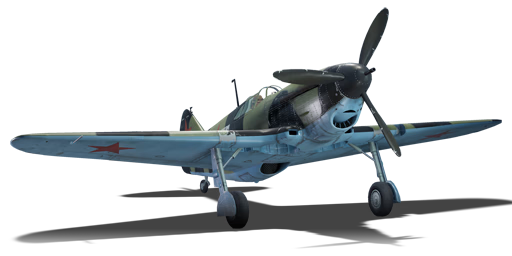


The LaGG-3-34 was a Soviet fighter aircraft, a variant of the LaGG-3 fighter. The 20 mm ShVAK shooting through the propeller hub was replaced by 37 mm NS-37 cannon, allowing the aircraft to be used in tank busting roles similar to the later Yak-9T. 40 of the LaGGs were sent to Stalingrad in 1942 for evaluation. However, the installation of the gun shifted center of gravity forward and caused stability issues, while the recoil from the cannon caused engine damage such as oil leaks and ruptures of piping. The aircraft was not developed further.
The LaGG-3-34 was introduced in Update 1.41.27 through the LaGG-3-34 starter pack. From 2014 to 2019, it was purchasable in the store as part of several premium packs but was removed at the beginning of 2019. It was also made available in parallel in the Warbonds shop as a random prize of the Vehicle battle trophy from September 2018 to March 2019 and from March 2020 to October 2020. The LaGG-3-34 makes for perfect CAS aircraft due to its 37 mm cannon into ground battles, as well as as a fighter capable of defending itself. The LaGG fulfils the same role of the later Yak-9T although at a lower battle rating, as well as with slightly worse performance more comparable to the early Yak-9.
flaps
flaps
flaps
brake
| Belt | Belt filling | Armor penetration (mm) at a distance: | |||||
|---|---|---|---|---|---|---|---|
| 10 m | 100 m | 500 m | 1000 m | 1500 m | 2000 m | ||
| AP-T/HEI-T | 71 | 68 | 57 | 46 | 37 | 30 | |
| HEI-T | 9 | 8 | 7 | 6 | 5 | 5 | |
| AP-T | 71 | 68 | 57 | 46 | 37 | 30 | |
| Belt | Belt filling | Armor penetration (mm) at a distance: | |||||
|---|---|---|---|---|---|---|---|
| 10 m | 100 m | 500 m | 1000 m | 1500 m | 2000 m | ||
| T/AP/AP/IAI | 32 | 30 | 22 | 15 | 11 | 7 | |
| AP-I/API-T/IAI/IAI | 29 | 27 | 20 | 13 | 9 | 6 | |
| API-T/AP-I/AP-I/IAI | 29 | 27 | 20 | 13 | 9 | 6 | |
| AP-I(c)/AP-I/AP-I/API-T/IAI | 34 | 32 | 24 | 17 | 12 | 8 | |
| API-T | 29 | 27 | 20 | 13 | 9 | 6 | |
| AP-I/AP-I/IAI | 29 | 27 | 20 | 14 | 9 | 6 | |







 2 x (40 / 75 / 170) %
2 x (40 / 75 / 170) % 
 2 x 118 %
2 x 118 % 

Flight performance | |
|---|---|
Survivability |
|---|
Weaponry |
|---|